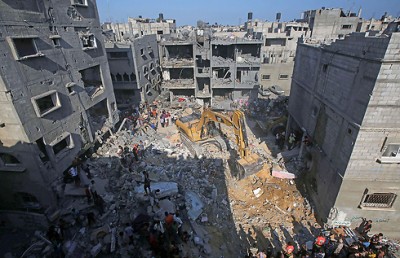Rafah on the Border with Gaza: 3,300 Year Old City to be “Wiped Off the Map”

The city of Rafah has survived the invading armies of Assyria, Greece, and Rome, among others. It has outlasted Napoleon’s armies, the Mamluks, the British, and the Ottoman Empire, just to name a few.
Before this year is out, Rafah will cease to exist.
The city of Rafah, which has been a part of Egypt since the pharaonic period, is to be removed from the map; its residents relocated to the imaginatively named, yet-to-be-built city of New Rafah.
Rafah is located in the Sinai Peninsula in Egypt’s northeast, straddling the border with the Gaza Strip. It is home to thousands of families, all of whom will be forcibly relocated under plans to create a “buffer zone” on the border.

Just a week ago, the plan was to demolish 1,220 houses. The Egyptian method of enforcement was as simple as a forced confession.
With little warning, police notified residents that they would clear the area, and said they would forcibly seize the property of those who refused to comply.
Though journalists are forbidden in Egypt’s troubled easternmost governorate, images trickled out of families bearing bundles of clothes and belongings looking on powerless as army bulldozers destroyed their homes.
But soon the Egyptian government decided that these methods were too, how shall we say, respectful of human rights.
The entire border city of Rafah is to be levelled to the ground, Egyptian authorities have announced. “The establishment of a buffer zone requires the complete removal of the city. In fact, it will be completely destroyed,” said Abdel Fattah Harhour, governor of North Sinai, to which Rafah is administratively affiliated.
Soon, Rafah will be gone. What won’t be gone is all the intractable political problems of the region that is causing its destruction.
4:19 PM PT: On a tangent, I think its worthwhile to recall what sort of military dictatorship Egypt currently has in power.
The Rabaa massacre of Aug. 14, 2013, was Egypt’s Tiananmen Square. Egyptian security forces killed at least 817 people on a single day at Rabaa al-Adawiya Square alone, and more than 1,000 when including the number of casualties across Egypt. It was the biggest mass killing of civilians in modern Egyptian history. The butchery did not take place under the cover of darkness, or in a remote corner of the country, but in broad daylight in Cairo…
The killing was done by Egypt’s Central Security Forces and Special Forces in close coordination with the Egyptian Armed Forces, with few if any reported defections or refusals to open fire. Security forces began firing on civilians around 6:30 a.m., and over the course of 12 hours they continued emptying rounds of live ammunition into crowds of men, women and children who they had entrapped, despite repeated promises of a “safe exit.” This was not a brief killing spree that ended as suddenly as it began, or the panicked response of threatened conscripts in the fog of battle. One year later, not a single official has been held accountable.

